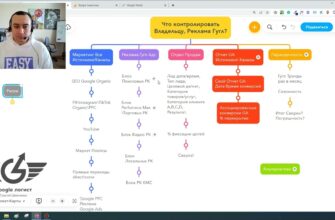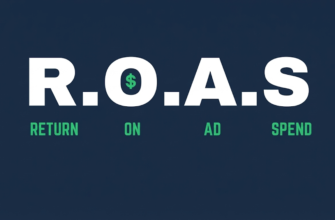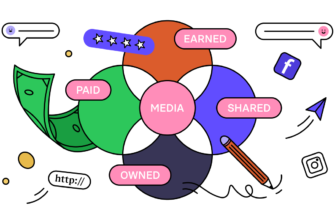- What are Google Ads extensions?
- What are ad extensions for?
- Advantages of using extensions in Google Ads
- What types of extensions are available in AdWords?
- Types of manual contextual advertising extensions
- Additional links
- Addresses
- Phone numbers
- Messages
- Links to applications
- Reviews
- Clarifications
- Structured descriptions
- Prices
- Partner addresses
- Promotions
- Messengers
- Lead form
- Images
- Automatic addresses
- Automatic telephone numbers
- Types of automatic extensions
- Seller rating
- Dynamic additional links
- Dynamic structured descriptions
- Dynamic refinements
- How does Google decide which extensions to show?
- How do I add extensions to Google Ads?
- Tips for using add-ons
Everyone who sets up contextual search advertising on Google uses ad extensions in one way or another. When configured correctly in the contextual advertising system, they can be considered a competitive advantage.
They help attract additional traffic, increase the space occupied by the ad on the page, and improve the overall effectiveness of the advertising campaign. Therefore, in order to achieve the goals set for the search campaign, it is necessary to know and understand what extensions exist and how they are used.
What are Google Ads extensions?
In general terms, these are blocks of additional information about the properties of the advertiser’s product, which are added to the structure of the advertising offer in a specific order. For example, physical address, rating, call button, and so on. They make the offer visually more interesting and attractive, and also facilitate navigation.
How many calls and sales will I get by ordering contextual advertising from you?
I need to calculate the conversion of my website Describe
the task
in the application
Calculate potential ad revenue Google
contextual advertising calculator
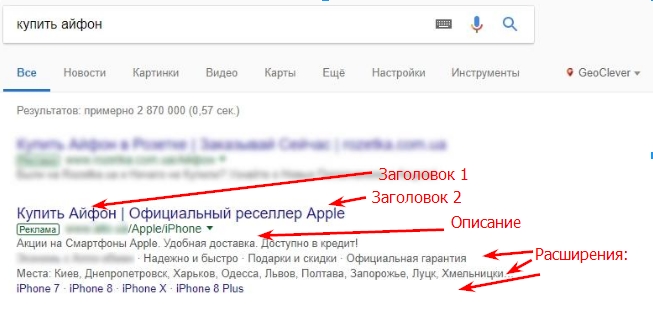
Important! Google ad extensions are only displayed if the algorithm deems it necessary, and ads are shown in the top ad block, so all the main parameters must be included in the text.
What are ad extensions for?
Their main purpose is to add additional information about the advertiser and their product to standard Google Ads text ads. The information will be highlighted in blocks and displayed when the search network considers it relevant to the target query.
In addition, having more information makes the offer comprehensive and attractive, allowing customers to see contact details, call, or write a message directly in the search results without even going to the page.
Some ad extensions in Google Ads are created in auto mode if text ad performance is expected to improve. However, you shouldn’t place too much hope in artificial intelligence. It is best to configure settings manually from the outset.
Tip! Additional information sets the advertiser’s company apart from the rest and allows it to get more clicks. Consequently, the conversion rate will increase, which will lead to an increase in the quality score and a decrease in the average CPC.
Advantages of using extensions in Google Ads
Ad extensions in AdWords make your ad more informative and noticeable. When used in advertising campaigns, extensions:
- Increase clickability. Additional lines of text, links, and buttons attract more attention to ads. Google statistics show a 10-15% increase in CTR after adding extensions. For example, if previously 4 out of 100 people clicked on your ad, with extensions this number can increase to 5 people.
- Improve quality scores and reduce costs. Google takes into account the presence and relevance of extensions when evaluating ad quality. The higher the quality score, the better your position in the search results will be at a lower bid. At the same time, clicks on extensions cost the same as regular clicks—no additional costs.
- They help convey more information to the customer. Potential buyers will be able to see the contact phone number, exact store address, opening hours, or links to popular sections of the website right in the search results.
- They help you stand out from the competition. When several similar offers are displayed side by side, users will choose the one that provides the most useful information. If your competitor has a simple text ad, while yours shows the price, reviews, and additional links, the choice is obvious.
- They take up more space on mobile screens. On smartphones, an expanded ad can take up the entire first screen—users don’t even need to scroll to see competitors. Considering that most search queries now come from mobile devices, this is a significant advantage. The ad looks neat, is easy to read, and is easy to click on with your finger.
What types of extensions are available in AdWords?
There are three main types:
- customizable independently;
- automatic;
- automatic with adjustable settings.
The difference is that in manual product information, it is developed and entered independently by the advertiser, while in automatic product information, it is developed and entered using built-in AdWords algorithms.
It is preferable to configure Google Ads extensions yourself. This way, the process of displaying information becomes controllable, and each ad becomes unique.
Types of manual contextual advertising extensions
In most cases, when it comes to contextual advertising ad extensions, manual extensions are implied. The reason is that they are given priority in ranking. Let’s take a closer look at their varieties.
Additional links
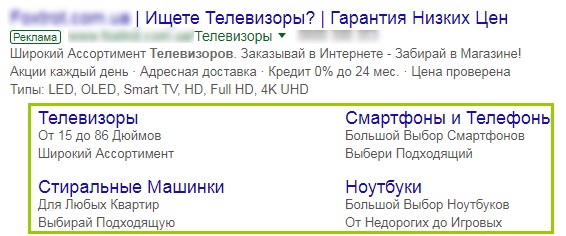
The point is to direct potential customers to the right pages before they go to the advertiser’s site. When displayed, the text describing the direction of the transition (sections of the site) is shown. When setting up, make sure that the links are either universal or as relevant as possible to the query and not irrelevant. It is also advisable to place additional links to social media accounts.
The text and URLs of links can be updated at any time without changing the content of the ad itself. The description under the link is added automatically, but can also be written manually. The minimum number of links to be displayed is 2, and the maximum is 10.
Addresses

They are crucial for local businesses with a specific physical location. They allow you to display your address, map pin, opening hours, and phone number before visitors even go to your website. This makes it much easier for potential customers to find your location. This feature works provided you have a linked My Business account and this information has been entered into it. Added automatically by default, but can be configured manually.
Phone numbers

According to Google, using a phone number increases clicks by an average of 4-5%. An interactive button appears in search results on smartphones, which allows users to call without manually dialing numbers or navigating to the target resource. This reduces the number of steps required to contact the company.
Although Google Ads pulls the phone number from the website, it is better to add it yourself right away. When creating a display schedule, take into account the operators’ working hours and select only those hours when the phone will be answered.
Messages
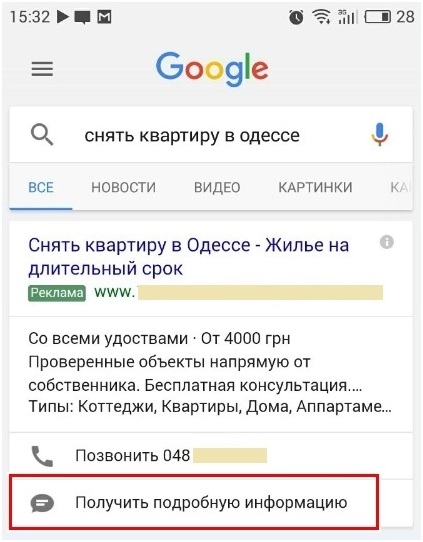
Modern young people increasingly prefer to write messages instead of making phone calls. Similarly to phone numbers, users can ask questions directly from search results.
Frequently asked questions templates can be set up. The conditions for display are mandatory registration of the advertiser and payment of the cost of sending the message. For correct operation, it is necessary to specify the display time corresponding to the operators’ working hours.
Links to applications
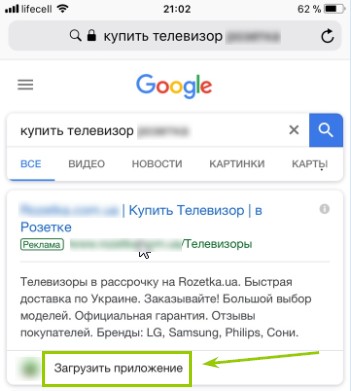
Allows you to add a “Download app” button to your ad. It appears in mobile searches, directing users straight to the app without going through the website. Using this link increases ad visibility and simplifies user interaction with content.
Please note! Google automatically recognizes the device from which the search is being performed (e.g., iOS or Android) and redirects the user to the appropriate app store (Apple Store, Huawei App Gallery, or Google Play).
Reviews

Human psychology is based on trust in stories about someone else’s experience, and decisions are easier to make on that basis. Many marketing strategies are built on this principle. The principle of operation is based on building trust among the target audience.
Reviews from third-party resources about a product or service are linked to the ad. It is important to pay attention to the trustworthiness of these resources (user trust, traffic) and, accordingly, monitor responses for negative feedback. Reviews are only displayed when searching from a computer.
Clarifications
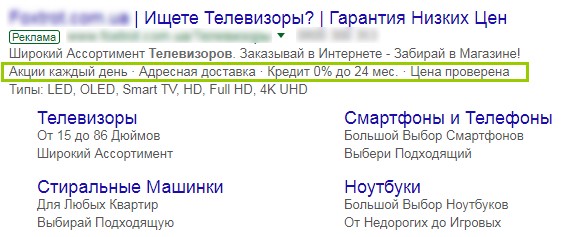
This is a block of non-clickable text. It emphasizes the uniqueness of the commercial offer, what distinguishes it from competitors in a specific market segment.
It is advisable to highlight the main competitive advantages and reflect them in the form of specific indicators (warranty, service, quality). In search results on computers and smartphones, this is displayed as text at the bottom of the ad, containing 2 to 6 clarifications.
Structured descriptions
This extension adds additional details to the ad in the form of thematic categories with lists. Think of it as a mini-showcase below the main ad text, where you can convey the most important information about your company in a few short phrases.
Here’s how it works: You pick a ready-made headline from Google’s list (you can’t make your own) and add up to 10 points under it, each with 25 characters. The result is a compact but informative block that helps users quickly assess a specific offer.
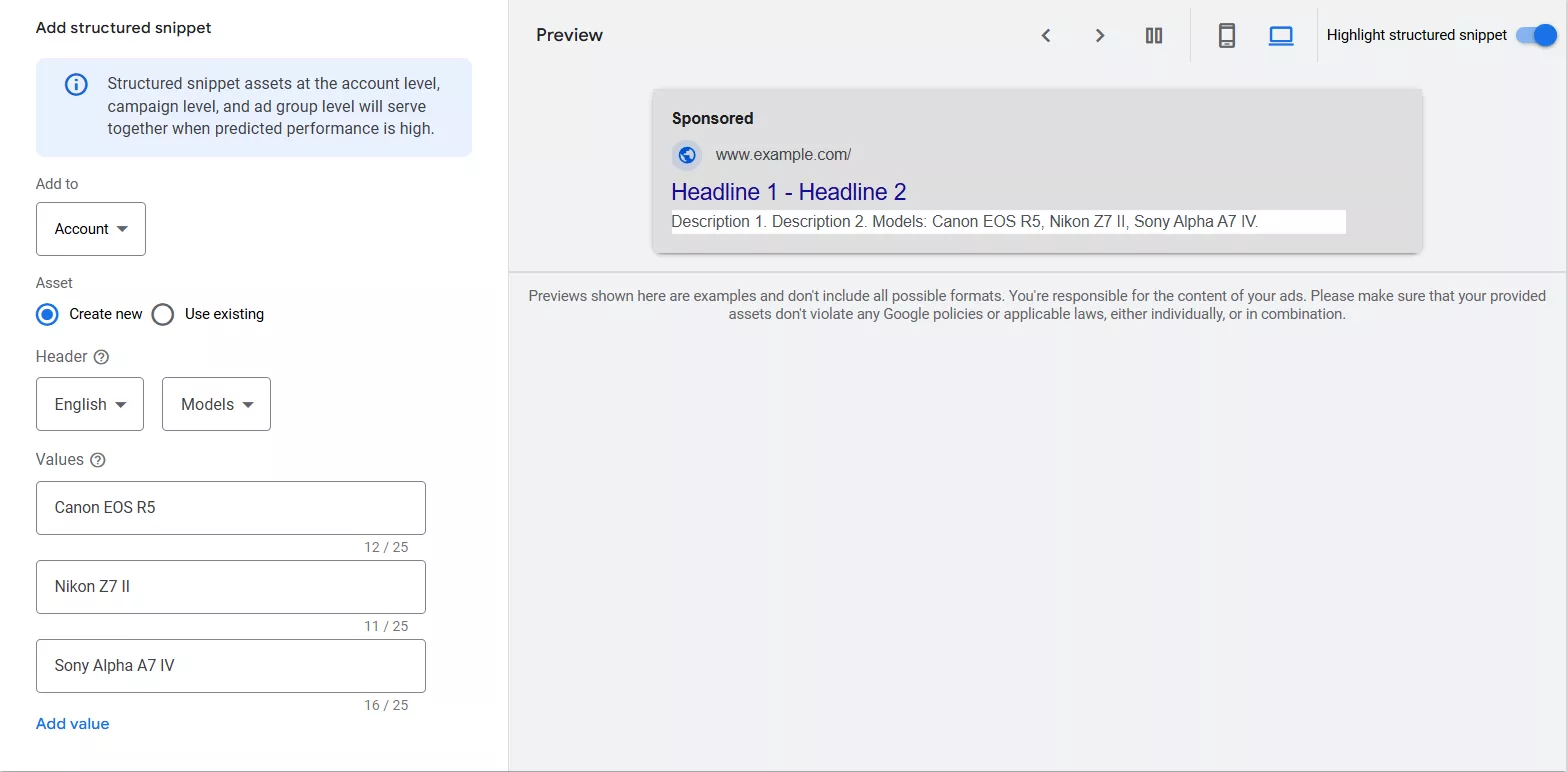
The following categories are available for structured descriptions:
How many calls and sales will I get by ordering contextual advertising from you?
I need to calculate the conversion of my website Describe
the task
in the application
Calculate potential ad revenue Google
contextual advertising calculator
- Brands. Allows you to show which manufacturers’ products are in your range. An ideal feature for multi-brand stores or car dealerships. For example: Nike, Adidas, Puma, Reebok.
- Amenities. Provides an opportunity to highlight additional services and comfort for customers. Most popular among hotels, restaurants, and beauty salons. For example, for a café, this could include: a summer terrace, live music, business lunches, and delivery.
- Neighborhoods. Here you can specify the areas where you operate or provide services. This is useful for local businesses with multiple locations. Example for a delivery service: Pechersk, Podol, Obolon, Solomenka.
- Courses. Here you can present a list of short-term educational programs for schools, training centers, and online academies. For example, for an IT school: Python, Java, testing, DevOps.
- Locations. The company’s geographical presence — here you can specify cities, regions, countries. Example for a chain of offline stores: Dnipro, Zaporizhia, Kryvyi Rih, Mykolaiv.
- Models. Specific names of products from the range. Suitable for appliances, cars, equipment. For example, for an online smartphone store: iPhone 15 Pro, Galaxy S24, Pixel 8.
- Educational programs. Long-term programs leading to a diploma or certificate for universities, colleges, and business schools. For example, for a university: bachelor’s degree in IT, master’s degree in marketing, MBA.
- Services. Main areas of the company’s work. Universal category for service businesses. Example for a law firm: company registration, tax disputes, legal representation.
- Recommended hotels. List of partner hotels for travel agencies and booking platforms. Examples: Ibis Styles, Holiday Inn, InterContinental, Fairmont.
- Styles. A structured description that works for both goods and services—interior design stores, clothing stores, salons. Example for a furniture store: Scandinavian, loft, classic, minimalism.
- Insurance coverage. Types of insurance in the company’s portfolio. For example: comprehensive insurance, compulsory motor third-party liability insurance, travel insurance, accident insurance.
- Types. Varieties of products or services within a single category. For example, for a beauty salon: haircuts, coloring, laminating, keratin treatments.
- Shows. Entertainment formats for theaters, concert venues, and event agencies. For circuses, you can specify: acrobatic shows, illusionists, animal training, clowning.
Prices

The ability to display product pricing information directly below the text. If the user is satisfied with the price, they click on the URL and are taken to the page for the product they are interested in.
When configuring, specify prices and landing pages for each product or service. It is worth describing the advantages of your product and its features. Do not forget to update prices and take into account promotions and discounts.
Partner addresses

If the advertiser’s product is sold through a network of distributors, you can connect their locations to Google My Business, thereby helping to increase your sales.
By publishing partner addresses, customers can find out which stores they can buy products from. Connecting is as simple as possible—you only need to specify the location of the points of sale where the advertiser’s product is sold. The system then works autonomously.
Promotions

Shows users information about current discounts and special offers directly in the ad. You can specify the discount amount (as a percentage or a specific amount), the promotion period, and link it to holidays such as Black Friday, New Year’s, March 8, or summer sales.
Why it works: People always pay attention to attractive offers. Phrases such as “30% discount” or “Free shipping” instantly catch the eye and significantly increase the desire to click on an ad. Statistics show a noticeable increase in CTR when using promotions, especially during holiday periods.
How to set up an effective promotion:
- Specify the specific benefit: “25% off the entire range” works better than simply “Sale.”
- Set a time limit: “Only until December 31” creates a sense of urgency.
- Link to events: “New Year’s discounts” and “Gifts for February 14” are clear triggers for purchases.
- Combine different types of promotions: percentage discounts for expensive items, fixed amounts for inexpensive items.
Messengers
Allows you to add a button to your ads to contact a company consultant via popular messengers such as WhatsApp, Facebook Messenger, or other platforms. Customers will be able to write to you directly without leaving their usual communication channel.
This works especially well for businesses where customers often consult before placing an order. For example, a buyer sees an ad from a furniture store in a search and immediately asks on WhatsApp about the dimensions of a particular sofa or delivery times. You respond instantly, while the person is most interested in making a purchase.
Lead form

This extension adds a form to smartphone ads for collecting potential customer contacts. After clicking, the user is taken to a ready-made form where their name and email address are automatically pulled from their Google account. All they have to do is click “Send” and you have their contact details.
Advertisers enjoy a host of benefits when using this tool. For example:
- The customer does not need to go to the website and search for the application form;
- Google automatically saves all orders for 30 days;
- The data can be downloaded in CSV format and uploaded to a CRM system.
- The collected contacts can be used when setting up remarketing.
Important note: these forms can only be configured at the level of the entire advertising campaign, not for individual ads.
Images
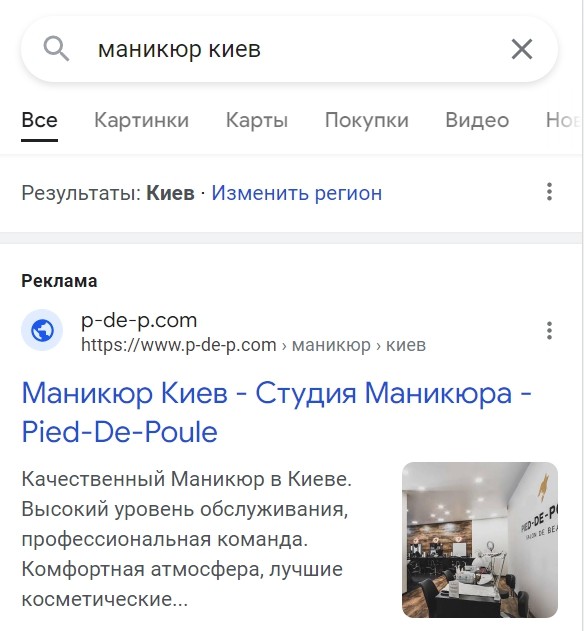
Visual extensions add images to text ads, making them more noticeable and understandable. Google allows you to upload up to 20 images per ad, but experience shows that 3-4 high-quality photos work more effectively than a dozen mediocre ones.
Images work especially well for online stores. Imagine: a person searches for “red Nike sneakers” and sees exactly that model in an ad — the likelihood of a click increases significantly.
Google has the following technical requirements for images:
- Place the main subject in the center; it should occupy at least 80% of the frame.
- No inscriptions, watermarks, or logos on top of the photo;
- The image must be sharp, without blurring or distortion;
- Collages consisting of several photos in one are prohibited;
- The image should show exactly what the user will see on the website;
- Only real photos without excessive editing are allowed.
Automatic addresses
The extension shows interested users where your company’s office or point of sale is located, as well as the shortest route to get there. An interactive map or link to the address you specify will appear in the ad. By clicking on it, users will see information about the company and be able to plan their route.
Automatic telephone numbers
If the maximum number of calls is set as one of the goals of your Google Ads advertising campaign, the system can automatically add a phone number to your ads. This will allow users to call you with a single click of the mouse.
Payment for this type of ad is charged per click. Thus, if call tracking is enabled on the website, clicking on a phone number can be counted as a separate conversion.
Types of automatic extensions
When the AdWords algorithm determines that adding an extension would improve the effectiveness of an advertising campaign, it will automatically create one based on the content presented on the resource and display it below the ad. The disadvantage of such additions is that they are uncontrollable and have a lower priority than manual ones. However, it is not recommended to disable them.
Since it is not possible to control their display, it is preferable to use customizable ones in order to control the campaign process and its effectiveness.
There are seven types of automatic extensions supported by the Google Ads system.
Seller rating
It generates a rating for the advertising company based on data extracted from reliable review sources, consisting of 5 stars. At the same time, there are certain requirements for the number and quality of reviews on third-party platforms in order to generate an adequate assessment.
Dynamic additional links
Generated link to the most popular categories or landing pages. If there are relevant additional links configured manually, dynamic links are not displayed.
Dynamic structured descriptions
They are generated automatically based on the content of the target website. It is not advisable to leave descriptions to the system’s algorithms, as there is a risk of receiving unclear machine-generated text that may discourage potential customers.
Dynamic refinements
AdWords are created so that users can understand whether it is worth visiting the website or not (whether the content of the website matches their query). The situation is similar to dynamic descriptions—manual configuration is required.
Linking to your Google My Business account enables the following automatic additions:
- Phone number;
- Messages;
- Addresses.
How does Google decide which extensions to show?
By default, not all ad extensions added to Google Ads will be displayed in search results. The visibility of extensions depends on:
- Advertisement rating. Its value is influenced by the set bid amount, the minimum advertisement rating, the context of the search query, and the quality indicators of both the advertisement itself and the landing page. The expected effect of displaying extensions and other advertising formats also plays a role. The extension will only be displayed if the rating meets the specified criteria.
- The position that an ad occupies on a search results page. Priority is given to ads that are higher up on the page. The lower the ad is positioned, the less likely it is that its extensions will be displayed.
How do I add extensions to Google Ads?
Extension settings in Google Ads are available in two places in the advertising account. The first method is through the main menu: go to the “Ads and assets” section, then select the “Assets” tab. The second option is to add extensions directly when creating a new campaign or while editing existing ads. 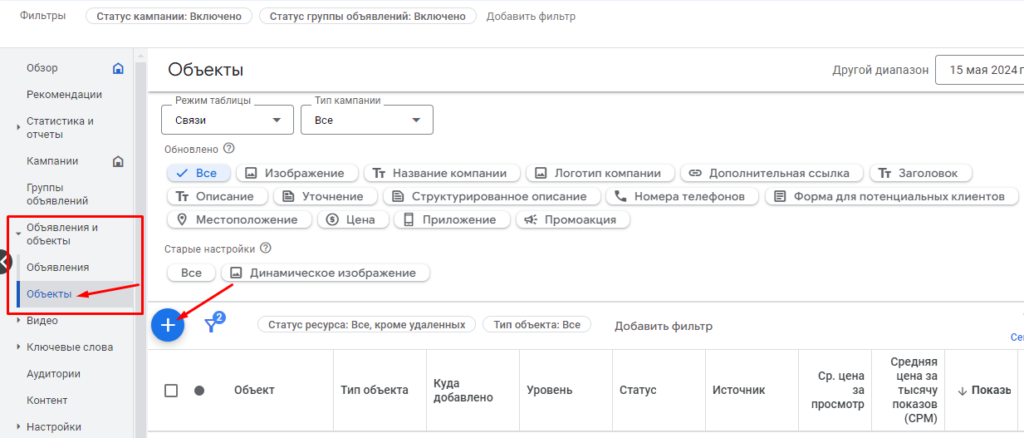
The process of adding is simple: click the “+” button and a complete list of available extensions will open. Select the type you need — for example, phone number or additional links — and fill in the required fields.
Interesting point: this menu also has an “Automatic extensions” section, where you can enable features that Google will generate independently based on your website’s content.
After creating the extension, you gain access to important information:
- Moderation status. Each extension is reviewed by Google. This usually takes from a few hours to a day. If moderation is not passed, the system will show the reason, and you can correct the errors.
- Privacy settings. This shows what data is collected through the extension. For example, if you use lead forms, you will see information about the storage of user contact details.
- Detailed statistics. Google shows the effectiveness of each extension separately: how many times it was displayed, CTR (click-through rate), number of conversions.
Important! If you have multiple campaigns or a large product range, you can use commercial data feeds from your account’s shared library. This allows you to automatically update information in all extensions simultaneously.
Tips for using add-ons
There are several points to consider when deciding whether to include extensions in your advertising campaign:
- The set is selected automatically. Since the contextual advertising system itself decides which ones to display and which ones not to, the best solution is to add as many extensions as possible. Ideally, several versions of the ad should be created so that Google can choose the most suitable one itself.
- Increase in cost per click. Often, adding extensions results in a higher average position in search results and, consequently, a higher cost per click. Some people mistakenly remove them, when in fact they need to adjust the price using bids.
- Quality requirements. Although customizable ads have an advantage in ranking, a weak call to action or an incorrect offer will drag the entire campaign down.
- Relevance. Google is constantly evolving and optimizing its search engine, which is why advertising offers containing only the most relevant content appear at the top of search results.




